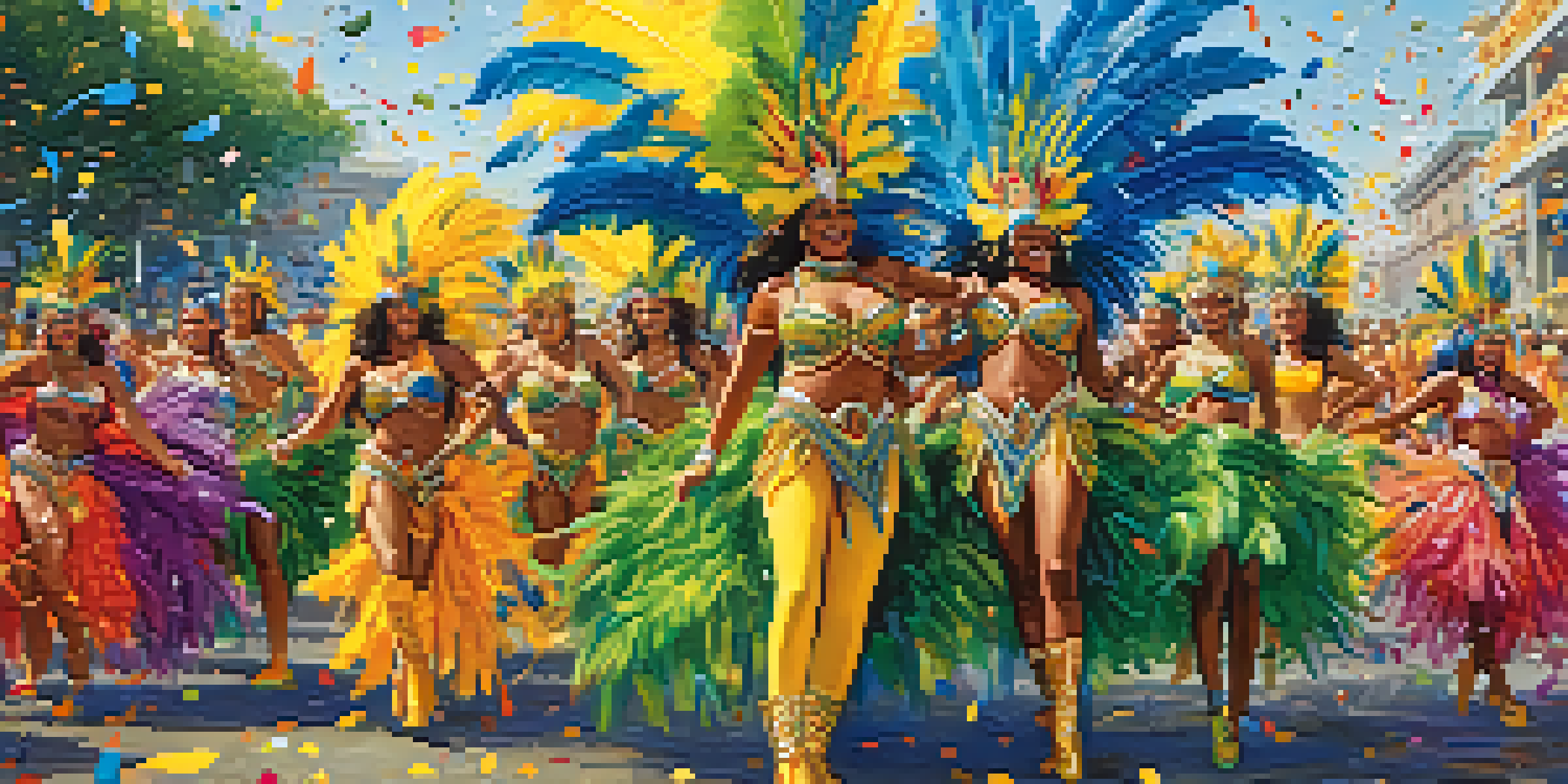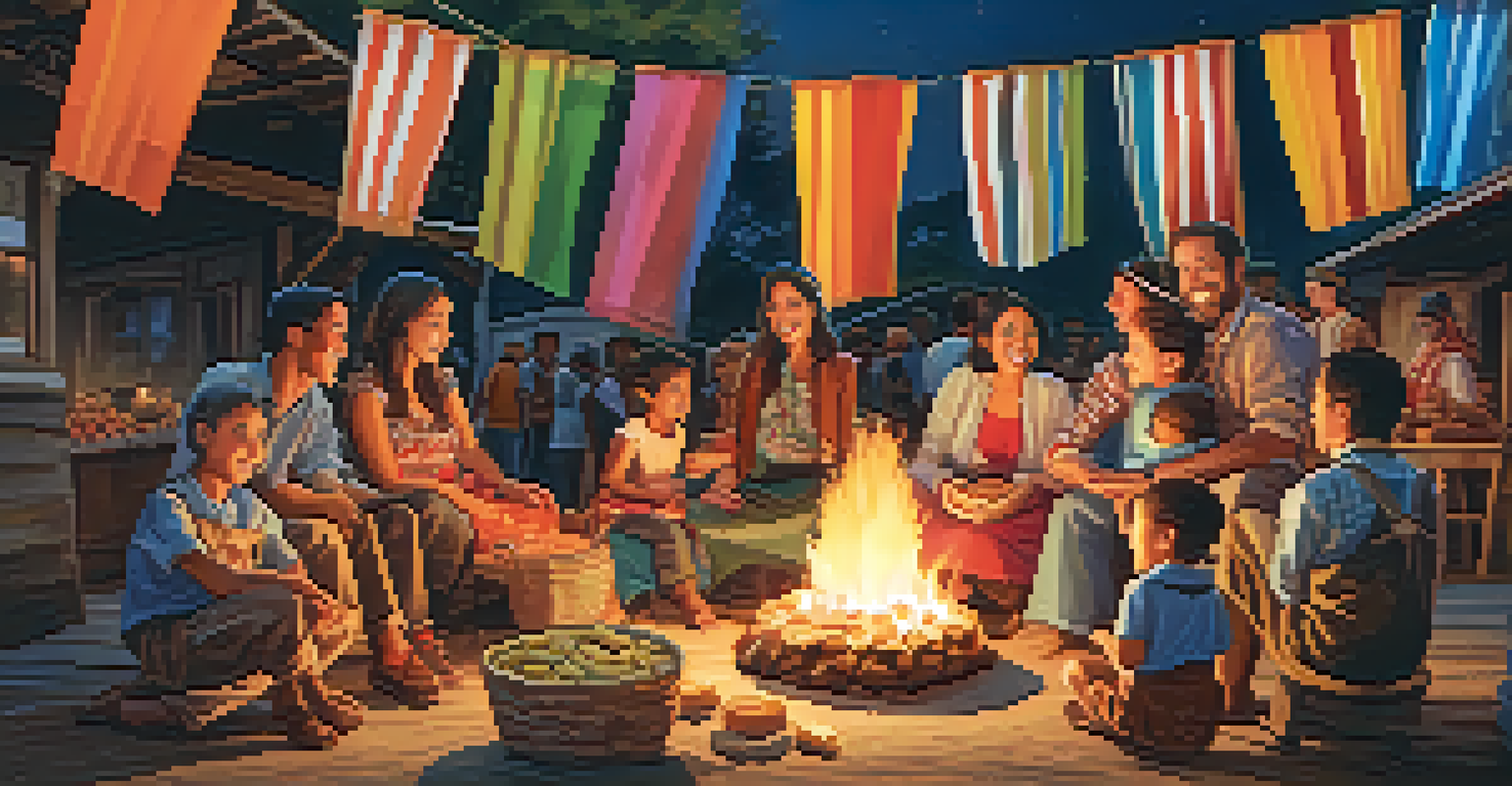Exploring the Vibrant Festivities of Brazilian Folklore Culture

Introduction to Brazilian Folklore and Its Significance
Brazilian folklore is a vibrant tapestry woven from the country's diverse cultures and traditions. It reflects a blend of indigenous, African, and European influences, showcasing the rich history of the nation. Through stories, music, and dance, folklore embodies the spirit of Brazilian life and serves as a means of preserving cultural identity.
Brazilian folklore is a vibrant tapestry woven from the country's diverse cultures and traditions.
At the heart of Brazilian folklore are its unique characters and myths, each representing different aspects of life and nature. For instance, the legendary figure of 'Saci Pererê' is a mischievous one-legged boy who symbolizes trickery and adventure. These tales not only entertain but also impart valuable life lessons, connecting generations through shared narratives.
As we delve deeper into Brazilian folklore, we can appreciate how these stories and traditions foster community bonds. Festivals celebrating folklore are not just events; they are a celebration of identity, resilience, and creativity that unite people in a shared cultural experience.
Festivals: The Heartbeat of Brazilian Folklore
Festivals in Brazil are a colorful showcase of folklore culture, where music, dance, and art come alive. One of the most famous is the Carnaval, a vibrant celebration that combines samba, parades, and elaborate costumes. This annual event draws millions of participants and spectators, transforming cities into a kaleidoscope of sound and color.

Another important festival is Festa Junina, celebrated in June, which honors rural traditions with traditional foods, bonfires, and folk dances. The atmosphere is filled with joy as families come together to celebrate their agrarian roots. This festival highlights the simplicity and warmth of Brazilian life, emphasizing community and togetherness.
Folklore Weaves Brazil's Identity
Brazilian folklore reflects the nation's diverse cultural heritage, blending indigenous, African, and European influences.
These festivals are not just about entertainment; they are vital for preserving folklore and passing it on to future generations. Each dance step, song, and story shared during these festivities helps keep the cultural flame alive, ensuring that Brazil's rich heritage continues to thrive.
Traditional Music: A Sonic Expression of Folklore
Music is an integral part of Brazilian folklore, serving as a powerful medium for storytelling and cultural expression. Styles such as Forró, Axé, and Samba tell stories of love, struggle, and everyday life, resonating deeply with the audience. Instruments like the berimbau and accordion add distinct sounds that bring these stories to life.
Through music, dance, and storytelling, it fosters a sense of unity, reminding us of the shared human experience that transcends cultural differences.
The rhythms of Brazilian music are infectious, often inspiring spontaneous dance and celebration. For instance, the fast-paced beats of Samba invite everyone to join in, creating a sense of unity among participants. This communal experience is a hallmark of Brazilian culture, where music serves as a bridge connecting people from all walks of life.
Moreover, traditional music often incorporates elements from various cultures, showcasing Brazil's rich diversity. This fusion not only adds depth to the music but also reflects the country's historical complexities, making it a captivating aspect of Brazilian folklore.
Dance: The Language of Brazilian Folklore
Dance is a vital form of expression within Brazilian folklore, conveying emotions and stories without the need for words. Each dance style, from the lively movements of Samba to the graceful steps of Frevo, tells its own unique story. These dances are often performed during festivals, providing an exhilarating experience that captivates both participants and spectators.
For many Brazilians, dance is more than just an art form; it is a way of life. The vibrant movements reflect the energy and passion of the culture, allowing individuals to express their identity and heritage. Dance also fosters a sense of community, as people come together to celebrate their shared traditions.
Festivals Celebrate Community Spirit
Festivals like Carnaval and Festa Junina play a crucial role in preserving folklore and fostering community connections.
Additionally, dance serves as a means of cultural preservation, ensuring that the stories and rhythms of the past are passed down through generations. By engaging in these traditional dances, the youth connect with their roots, keeping the spirit of Brazilian folklore alive and thriving.
Mythical Creatures: The Legends of Brazilian Folklore
Brazilian folklore is rich with mythical creatures and characters that embody various aspects of life and nature. These figures, such as 'Curupira,' the protector of the forests, and 'Iara,' the water goddess, play significant roles in local legends. Each creature has its own unique story, often reflecting moral lessons or the importance of respect for nature.
These mythical beings are not just figments of imagination; they represent the values and beliefs of Brazilian society. For instance, tales of Curupira remind people of the importance of environmental conservation, emphasizing the need to protect the land. Such stories are particularly relevant in today's context of climate change and deforestation.
Moreover, the rich tapestry of these legends showcases the creativity and storytelling prowess of Brazilian culture. As families share these tales, they keep the folklore alive, ensuring that the essence of these mythical creatures continues to enchant and educate future generations.
Culinary Traditions: A Taste of Folklore
Food plays a vital role in Brazilian folklore, with traditional dishes often tied to cultural celebrations and rituals. Each region boasts its own specialties, such as Feijoada, a hearty black bean stew, and Pão de Queijo, delicious cheese bread. These dishes tell a story of Brazil's diverse culinary heritage and reflect the country's agricultural bounty.
During festivals, food becomes a central element, bringing people together to share and enjoy. For example, during Festa Junina, participants indulge in traditional treats like corn cakes and sweet potatoes, creating a festive atmosphere filled with warmth and camaraderie. Sharing food helps strengthen community bonds, reinforcing cultural ties.
Music and Dance: Cultural Expressions
Traditional music and dance serve as powerful mediums for storytelling and cultural preservation in Brazilian folklore.
Moreover, the preparation and consumption of traditional dishes often involve rituals and customs passed down through generations. These practices not only preserve culinary traditions but also create lasting memories, making food a cherished aspect of Brazilian folklore.
The Global Impact of Brazilian Folklore
Brazilian folklore has not only shaped the country's cultural landscape but has also made a significant impact on the global stage. The rhythms of Samba, the vibrancy of Carnaval, and the stories of mythical creatures have inspired artists and musicians worldwide. This cultural exchange enriches the global tapestry, showcasing the beauty of diversity.
In recent years, there has been a growing interest in Brazilian folklore, with more people seeking to understand and appreciate its roots. Events and festivals celebrating Brazilian culture are popping up in cities around the world, bringing together diverse communities to share in the festivities. This global enthusiasm helps create a deeper appreciation for the intricacies of Brazilian heritage.

Ultimately, the allure of Brazilian folklore lies in its ability to connect people across borders. Through music, dance, and storytelling, it fosters a sense of unity, reminding us of the shared human experience that transcends cultural differences.